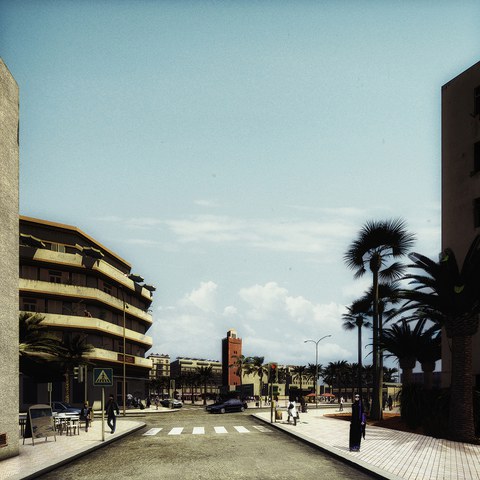Aug 10, 2018
Casablanca comes to the Palais in the Great Garten

district planning of El Hank
15th Architecture Prize awarded for innovative Moroccan district planning El Hank
Casablanca, Morocco's largest city, was immortalised by the eponymous classic film. It is a city with an eventful history: Casablanca was first named Casa Branca by Portuguese conquerors in the 16th century, renamed Ad-Dār al-bayḍāʾ by the Arabs after an earthquake, and finally received its current name from Spanish merchants in the 19th century. In the city, 18th century Moorish architecture and a modern European flair form a contrast to the slums, the Bidonvilles, which emerged in the early to mid-20th century. Some of these districts, such as El Hank, are about to be demolished and completely transformed as a result of rapid population growth. The architecture student Farhad Babayev has created a new design for El Hank as part of a student research project at TU Dresden. Today, on 10th August 2018, the jury of architects and landscape architects announced their decision: Babayev is the first place winner of the Architecture Prize. To reach this decision, Prof. Carsten Lorenzen and the jury reviewed 130 projects and Diplom theses from the past academic year on diverse architectural topics such as monument preservation, public buildings and urban development.
Babayev's work made it through all three selection rounds – the preliminary selection, the presentation in front of the jury during the first round and the final round with ten remaining entries. The jury consisting of Adrian Dorschner (Architekturwerkstatt FHS St. Gallen), Florian Fischer (Almannai Fischer Architekten, Munich), Bettina Kunst (Hochschule Bremen, TU Braunschweig, Hamburger Architektenkammer), Falk Leinert (LeinertLorenz Architekten, Dresden) and Jens Rossa (Architektenkammer Sachsen) were particularly impressed by the "simple but poignant analysis" and the "extremely delicate visualisations". According to Bettina Kunst, his "innovative contribution to urban development in the Arabic-influenced cultural sphere manages to entirely avoid replicating Moorish colonial clichés". The jury assessed whether the work conveys the essential message of the project, whether the concept is coherent and which topics are incorporated into it. Over and above this, the experts evaluated whether the design was visually appealing. Babayev’s student research project was developed in the context of the architecture specialisation course in urban development under Prof. Dipl.-Ing. Manuel Bäumler. Farhad Babayev explains that his design “makes apartments and houses of very different types possible. This not only translates and implements knowledge from Moroccan housing culture, but also faces the danger of transformation".
Second prize went to Vinzenz Müller for his design for the extension of the Natural History and Archaeological Museum Museo Naturalistico Archeologica in Vicenza. Third prize went to Klara Laux for her atmospheric planning of a crematorium and various types of spaces to bid final farewell at the Heidefriedhof Cemetery Dresden. Tobias Maisch, organiser of the Architecture Prize, is fascinated by the high quality, the students’ serious approach to the task, the attention to detail and the sophisticated quality of the models. "The Architecture Prize also manages to spread this message", says Maisch.
